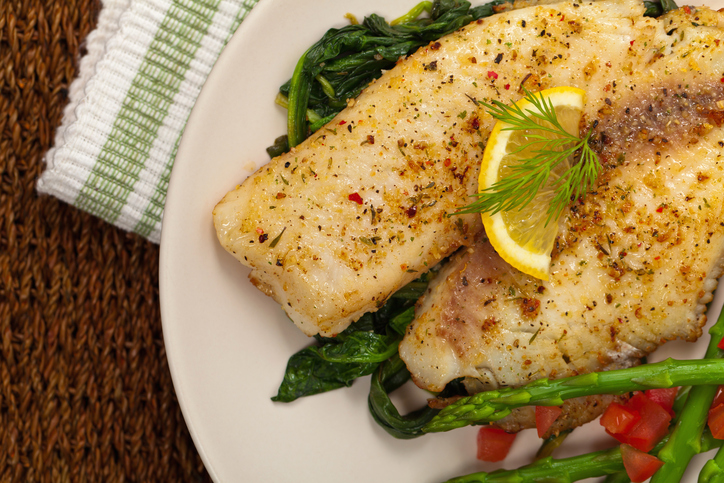When we say “whitefish” in a recipe or if you see a recipe for haddock but can’t find it in the grocery store, here’s what we really mean plus a few tips on ways you can select, prepare and cook it.
What is whitefish?
Whitefish is generally a mild-flavored, often slightly sweet fish, which can be interchangeable in recipes. These include wild Alaska pollock, bass, cod, grouper, haddock, and halibut. These are great for pan-frying, pan-searing, using soups and chowders, and baking. There are also some thinner fillets of white fish, which can be used in these recipes but keep in mind they cook much faster, including flounder, perch, plaice, and sole.
These species can be roasted, poached, steamed, sautéed, or lightly-fried for fish and chips. They are perfectly complemented by a vast array of sauces.
How do you prepare whitefish?
Whitefish is so easy to prepare and a great introduction for anyone eating fish for the first time! It can be delicate, so keep an eye on it while cooking so it is flaky vs. mushy (and it can go mushy in a matter of 30 seconds).
Here are some cooking methods great for whitefish:
- You can sauté or fry in an open pan in vegetable oil,
- dust both sides with seasoned flour and sear in vegetable oil and a bit of butter (avoids burning the flour),
- foil it up for the grill or oven like this Foil Packet Lemon & Herb White Fish, or
- simply put a lid on it and steam it with vegetables like this One-Pan White Fish Dish.
The name “whitefish” can be confusing because it is often used as a generic marketing term for many saltwater species of mild-flavored, white-fleshed fish. And, to top it off, there is an official “whitefish” that is a freshwater catch often caught in the Great Lakes.
Here are a few whitefish options to get you started:
Alaska pollock is America’s most popular fish you’ve likely never heard of. Known for its versatility, “Snow White” pollock flakes beautifully and offers a lean texture and mild taste – that’s why you find it in family favorites such as Filet-O-Fish, fish sticks, and delicious fish tacos. It’s found throughout the year in your grocery store’s freezer section. Alaska pollock boasts a whopping 27 grams of protein in just 127 calories, and even though it’s so lean, has more than 500mg of essential omega-3 fatty acids EPA+DHA per serving, making it highest in omega-3s for white fish.* Wild Alaska Pollock is also amazingly sustainable – it’s the largest fishery in the United States and the second-largest fishery in the world.
Cod is considered the leanest protein available, meaning the protein to calorie ratio beats out other foods. The fillets are moist and firm with a distinctive large flake and slightly sweet flavor. An excellent source of high-quality protein as well as selenium, potassium, and phosphorous. Due to its firm texture, it adapts well to most cooking methods.
Haddock is a popular option for fish and chips (just choose baked to retain the nutrients!) because of its light, slightly sweet flavor. At just 100 calories a serving,* this lean, flaky white fish is full of B vitamins — B-6 and B-12, niacin, thiamin, riboflavin, and folate — as well as more than 50% DV of immune-boosting selenium.
Halibut is known as the “steak of seafood.” It has a delicate flavor with a firm and flaky texture and pure, snow-white flesh. It has a good source of potassium and magnesium and is naturally lean. It maintains its shape and is suitable for all types of cooking methods, but is best for baking or roasting and is available fresh throughout the summer.
West Coast rockfish is probably the most full-flavored of the mild white fish, and its flavor profile lends itself to a wide range of rubs, marinades, and sauces. This fish has a rich firm, flaky texture. It’s good sautéed, roasted, broiled, or grilled, and it’s more available now that the canary rockfish fishery has rebuilt and is being fished at a sustainable level.
* We utilize information based on 4 oz. servings cooked, dry heat – through USDA’s common serving size for fish is 3 oz and kids are 2 oz., all the recommendations, including from USDA and FDA are for 2-3 servings a week or 8-12 oz.



Leave a Reply